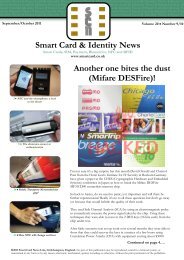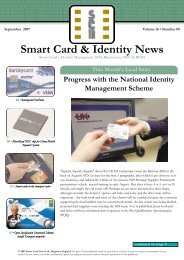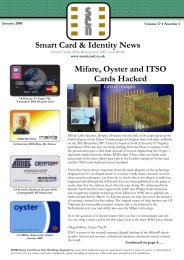Smart Card Identity News - Smart Card News
Smart Card Identity News - Smart Card News
Smart Card Identity News - Smart Card News
Create successful ePaper yourself
Turn your PDF publications into a flip-book with our unique Google optimized e-Paper software.
! Common law (US, UK, Australia, Canada), with no national ID card or identifier, and people relying<br />
instead on drivers' licenses and passports.<br />
! Civil law (most of the original European Union countries), with a mostly compulsory national ID card.<br />
! Nordic model (Denmark, Sweden, Norway and Finland), with a centralised unique identifier, and<br />
optional digital certificates on private-sector cards (e.g., banks).<br />
! Asian model (Malaysia, Hong Kong and Singapore), with compulsory multipurpose electronic ID<br />
cards.<br />
Several South American countries use the civil law identity scheme, as do many African nations, where biometric<br />
ID techniques are growing in acceptance. Mauritania and Nigeria require fingerprints for citizen identification,<br />
and Uganda uses face recognition for voting purposes. In South America, Peru stores fingerprint<br />
information in bar codes. The weakest link of current systems is enrollment. In other words, if an individual<br />
can easily be entered into an identity system by submitting false documentation, the system has serious flaws.<br />
Ahmed Rassam, who confessed participation in a plan to bomb the Los Angeles airport during New Year's<br />
2000, obtained a valid Canadian passport after having obtained a blank, stolen baptismal certificate. (An historical<br />
note, by the way: birth certificates were introduced to record life-expectancy statistics and were not<br />
intended to form the basis for strong personal identification.) In addition, seven of the 19 hijackers in the<br />
2001 terrorist attacks in the United States held valid drivers' licenses that were obtained with phony documents.<br />
We need security, but what about privacy? - Identification is not always required nor wanted. People<br />
expect anonymity at certain times: walking down a city street, seeing a movie, telephoning for quotes to compare<br />
prices, participating in surveys or clinical trials. At other times, establishing identity may be required initially<br />
(to determine voting eligibility, for example) but not later on so as to keep private the choices made by<br />
an individual. As with other technologies, biometrics are not intrinsically good or bad. Their application<br />
needs to be judged by intent and usage. In the futuristic movie "Minority Report," the law-enforcement officer<br />
played by Tom Cruise has his retinas scanned to gain access to high-security areas. This seems to be a<br />
worthwhile and convenient application of biometrics for work-related security. But the film also depicts a<br />
"Big Brother" environment as sensors scan the hero's eyes in public spaces to establish his identity and personalise<br />
holographic advertising messages. Since he seems unable to escape being bombarded by promotional<br />
messages, this application of biometrics seems invasive and offensive.<br />
Privacy issues are not exclusive to biometrics, and businesses and governments have recently tightened procedures<br />
and regulations to keep personal data from being misused or falling into the wrong hands. In Accenture's<br />
view, it is in the best interests of organisations to regulate themselves through the systematic development<br />
of trust. A company that is known to violate the privacy of customers is likely to lose business to competitors<br />
as word of ethical lapses spreads. The Organisation for Economic Co-operation and Development<br />
has an Information and Privacy group working to promote a "global, coordination approach to policymaking<br />
… and to help build trust online". In addition, the BioPrivacy Initiative of the International Biometric<br />
Group seeks "to increase the likelihood that biometric technologies, when deployed, will be as protective of<br />
personal and informational privacy as possible". Biometrics, for example, can strengthen privacy by denying<br />
access or release of confidential information to the wrong people.<br />
Best practice relies on multiple factors - How will organisations deliver a stronger, more reliable ID infrastructure?<br />
Amid the increasing volume and speed of international travel and commerce, governments must<br />
perform a balancing act. They must weigh security concerns with the needs of business people and the desire<br />
of tourists not to spend half of their trips abroad clearing security. Similarly, when venturing online, some<br />
users have so many passwords and user names to keep track of that secret-access codes end up written on<br />
Post-It notes stuck to computer terminals-so much for network security. The emerging wave of new systems<br />
aims for triple strength. In simple, non-technical language, they require something you have, such as an<br />
ID card or token; something you know- a PIN or password, or a shared secret; and something you are, supplied<br />
by biometric applications. When it comes to biometrics, no one system is best in all cases, and acceptability<br />
is an obvious concern.<br />
Industry Insight<br />
11<br />
<strong>Smart</strong> <strong>Card</strong> & <strong>Identity</strong> <strong>News</strong> • July 2007
















